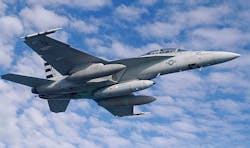Boeing to install infrared search and track systems on Navy carrier-based jet fighters
Officials of the Naval Air Systems Command at Patuxent River Naval Air Station, Md., awarded a $22.2 million contract modification this week to the Boeing Co. Defense, Space & Security segment in St. Louis for infrared search and track (IRST) systems for F/A-18E/F carrier-based combat jets.
The IRST systems for the Super Hornets are designed and manufactured by the Lockheed Martin Corp. Missiles and Fire Control segment in Orlando, Fla. It's called the IRST21 Sensor System, and fits on the front of the Super Hornet's centerline fuel tank.
The IRST contract modification is part of a $135 million contract to Boeing in August 2011 for the engineering, manufacturing, and development (EMD) phase of the F/A-18E/F infrared search and track system. EMD refers to full-scale development, which is one of the last steps before full-scale production.
The Super Hornet's IRST is a long-wave infrared detection system that targets airborne vehicles in a radar-denied environment, Navy officials say.
The system, which Boeing is buying from Lockheed Martin, uses infrared search and track technology to detect and provide weapon-quality track solutions fir potentially hostile aircraft, Lockheed Martin officials say.
Even amid electronic attack or heavy RF and infrared countermeasures, IRST provides autonomous, tracking data that increases pilot reaction time, enhancing survivability by enabling first-look, first-shoot capability, according to Lockheed Martin.
Infrared sensors like the IRST detect the heat from an aircraft's engine exhaust or even the heat generated by the friction of an aircraft as it passes through the atmosphere. Unlike radar, infrared sensors do not emit electronic signals, and do not give away their presence to adversaries.
Related: Lockheed Martin's SpectIR IRST system completes live fire test
The IRST21 system that Lockheed Martin is providing to Boeing offers increased discrimination of threat formation at relatively long ranges, enhancing multiple target resolution compared to radar, Lockheed Martin officials say.
This ability can enable Super Hornet pilots to make positive identification of enemy aircraft at long ranges, and enable them to fire their air-to-air missiles at their maximum ranges.
Data from the IRST system can stand alone or be fused with other on-board sensor data situational awareness. On the F/A-18 E/F, it mounts in the nose section of the centerline fuel tank. Lockheed Martin also is developing an IRST pod that can be fitted to the F-15C and F-16 jet fighters.
The IRST21 system is the next generation of the F-14D AN/AAS-42 IRST that accumulated more than 200,000 flight hours aboard U.S. aircraft carriers, Lockheed Martin officials say.
On the contract awarded this week, Boeing will do the work in St. Louis and in Orlando, Fla., and should be finished in September 2015. For more information contact Boeing Defense, Space & Security online at www.boeing.com/boeing/bds, Lockheed Martin Missiles and Fire Control at www.lockheedmartin.com/us/mfc, or Naval Air Systems Command at www.navair.navy.mil.
